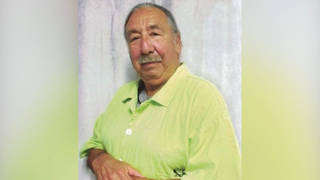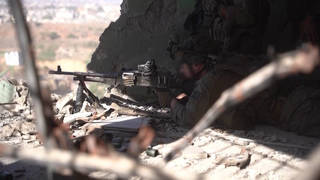
Related
Topics
Guests
- Gayla Benefieldan activist and advocate for victims of asbestos exposure for many years. She was one of the first residents in Libby to begin to raise awareness about the issue and helped the story gain national attention. Both her parents died from exposure to asbestos. She and her husband both have the disease. Thirty members of her extended family have been affected. She joins us on the telephone from Libby.
We broadcast from Missoula, Montana, where an environmental crimes trial is underway in what the government has called “the nation’s biggest environmental disaster.” Hundreds of miners, their family members and townsfolk have died, and at least 1,200 have been sickened, from exposure to asbestos-containing ore from a mine in Libby, Montana, owned by W.R. Grace and Company. We speak with Gayla Benefield, one of the first residents in Libby to raise awareness about the story and gain it national attention. Both her parents died from asbestosis. She and her husband both have the disease, and thirty members of her extended family have been affected. [includes rush transcript]
Transcript
AMY GOODMAN: We are on the road in our “Community Voices, Community Media” tour. We’re broadcasting from the University of Montana at Missoula. Here in Montana, an environmental crisis — has led to a crimes trial, underway — that the government has called “the nation’s biggest environmental disaster.”
Government prosecutors called their final witness on Monday in their case against W.R. Grace and Company. The firm and five former executives are charged with knowingly exposing their workers and the public to vermiculite ore contaminated with asbestos from the company’s mine in Libby, Montana.
Hundreds of miners, their family members and townsfolk have died, at least 1,200 have been sickened, from exposure to the toxic asbestos. W.R. Grace knew from the time it bought the mine in 1963 why the people in Libby were dying. But for the thirty years it owned the mine, the company did not stop it. Tens of thousands of internal company documents and court papers show years of extensive communication among the company’s top officials about concealing the danger of asbestos in the ore and the consumer products that were made from it. They discussed methods to keep federal investigators from studying the health of the miners and efforts to mask the hazard of working with the contaminated ore.
The mine was closed in 1990, but federal officials did not begin examining the hazards in Libby until 1999, when the Seattle Post-Intelligencer published a series of articles that broke the story. In the first article, journalist Andrew Schneider wrote, quote, “It takes anywhere from ten to forty years from the time a person is exposed to dangerous amounts of asbestos for the diseases to reveal themselves. So in Libby, the killing goes on.”
Gayla Benefield has been an activist and advocate for victims of asbestos exposure for many years. She was one of the first residents in Libby to begin to raise awareness about the issue and helped the story gain national attention. Both her parents died from exposure to asbestos. She and her husband both have asbestosis. Thirty members of her extended family have been affected. She joins us now on the telephone from Libby.
We welcome you to Democracy Now! Can you lay out for the listeners and viewers of Democracy Now! just what the history of your town of Libby is, how this all happened?
GAYLA BENEFIELD: Well, the vermiculite, as the product is called — it’s an insulating product — was discovered in the early 1900s in Libby. And actually, it was marketed, produced, everything else, right here from Libby under the trade name Zonolite. And the mine in 1962 was purchased by W.R. Grace, and it was one of the two industries that we had in Libby, the other industry being logging, and which comprised the majority of the workforce. This is a small mine that possibly employed 400 people at the maximum. But the mine continued to mine the ore and to ship the ore. Eighty percent of the world’s vermiculite came from Libby, Montana.
And my father went to work there in 1954, but by 1968 he was becoming very ill, short of breath. He was diagnosed with heart disease, arthritis, just like a lot of his coworkers were. But by 1971, he was finally diagnosed with asbestosis of the lung and given eighteen months to live. At that time, he was sixty-one years old. And he died in 1974 from asbestosis.
And the company didn’t really seem to be concerned about it. The men who worked there didn’t seem to be concerned about it. But I was very angry, because of his age. He was young, comparatively, at the time when he died. And so, I started investigating and simply watching the friends of — the fathers and the mothers of friends who had worked at the mine, because we were more or less a close-knit group.
And over time, I would find that more and more of these men had become ill and were on oxygen, and the explanation being, “Well, you smoked at one time.” I mean, this diagnosis — the diagnosis was never given in Libby to a miner. And by 1985, it became very apparent that — what was going on up at the mountain, and I constantly went from our governor all the way back down to our city council, back up to the governor, saying, you know, the men that are working up there are dying. It was very obvious to me.
And at that point, I was a meter reader for the power company, so I was literally in everyone’s backyards. In these backyards, I would find these men sitting on their porches with oxygen tanks. And they were men who had worked with my father. And it was a matter of connecting the dots. But I was terribly alarmed.
And in 1985, my mother, after being hospitalized yearly for pneumonia for the last seven years, was finally diagnosed with asbestosis, classic asbestosis, and it was caused by secondary exposure, which was totally unheard of. And I think from that point on, I really became vigilant. I became very outspoken towards the company.
And also at that point, there was a decision in the State Supreme Court called the Gidley-Priest decision that allowed people to go back and sue W.R. Grace for the loss of a loved one, or the men could go back and actually sue for benefits. Because of the Workman’s Comp rules and the latency period of the disease, if they weren’t diagnosed within three years of working at the mine, they simply weren’t eligible for Workman’s Comp.
But in 1990, the mine shut down. And they claimed lack of — I’m not sure exactly what — they had all sorts of reasons why they shut down. But they did shut the mine down in 1990. And by then, my mother had passed away. I had filed suit against W.R. Grace in court. And I, along with four other cases that went to jury, received guilty verdicts for the death of my mother or for the sickness of certain persons.
And in 1999, I noticed a small article in the newspaper saying that they were going to give back the final amount of a reclamation bond, and the final amount was only $67,000. The full reclamation bond on the mine that was set in 1972 was a little over $500,000, which was ridiculous. But I protested that $67,000 returned, and I asked for an investigation of the mine site, because, to me, it did not seem reclaimed. Nothing was growing up there. I was still very cautious about W.R. Grace, because people were still being sickened and dying. And at that point, there was over 300 people in Libby who were diagnosed with the disease, and many of which had never worked at the mine, hadn’t — didn’t have anything to do with the mine. They simply had lived, worked or played in Libby.
And once I filed the complaint with the DEQ, Andy Schneider heard about it and came on the scene. And Andy being a professional investigator, a newspaper reporter, investigative reporter, immediately picked up on this and asked if I had anything to substantiate my stories. And by then, I had probably 10,000 court documents that I had gotten as a result of all of the cases in Libby. And those documents were totally damning. The confidential memos from W.R. Grace between their employees — between the — the people actually on trial and a lot of others. And so, probably the rest is history.
The story came out in the national newspapers, because our local papers simply refused to even cover the court cases in Libby. I mean, this was — these were monumental trials that we were holding against a Fortune 500 company and winning, and we could not get a reporter in the state to cover these trials at all.
AMY GOODMAN: We’re talking to Gayla Benefield. She is speaking to us from Libby. She and her husband both suffer from asbestosis. Thirty members of her extended family have died as a result. We’re going to go to break, and then we’ll be back with her, as well as two reporters who have been covering this issue now for quite a time. We’re reporting from Missoula, Montana, where this historic trial is taking place. Stay with us.
[break]
AMY GOODMAN: We are on the road in Missoula, Montana. We’re broadcasting from the University of Montana. We’re talking to Gayla Benefield. Thirty members of her extended family have been affected by the asbestos in Libby, Montana. Her husband and she both suffer from asbestos exposure as a result of the W.R. Grace plant that was operating for decades in her town of Libby.
I want to turn now to a documentary called Libby, Montana. It had its national broadcast premiere on PBS’s POV in 2007. Their website is pbs.org/pov. It tells the story of the residents of Libby. This is a clip of former W.R. Grace employee Les Skramstad. He worked in the mill only two years, but died of mesothelioma in 2007. He talks about what it was like to work in the mine.
LES SKRAMSTAD: My first experience there was, “What in the hell did I get myself into?” I just couldn’t believe the dust and the dirt. I went into the construction room, because that’s where I was told to report, and he told me I was going to be a sweeper in the dry mill, and I had no idea what he was talking about.
But first, you go over to the warehouse and get a respirator. I had this respirator on, and in about fifteen minutes, I couldn’t breathe. So I pulled this respirator off, and it was just plugged solid. I thought, “Boy, I’m not getting nothing done, and if I don’t, I’m going to get canned.” So I just pulled the respirator off and let it dangle around my neck here, and I really went to work.
And at noon, I went back down to eat lunch. And I was just covered with this dust everywheres. And Tom DeShazer was sitting in there, and he was foreman of the construction department, and he said, “How do you like that dust?” And I said, “Jeez, it’s the worst I ever seen, and I can’t imagine anything like it. It’s the worst I ever seen.” And jeez, they all laughed, you know, and slapped their leg and said, “Ah, it’s just a nuisance dust. You’ll get used to it.”
BOB WILKINS: This stuff was in your clothes. It was everywhere. It was so fine, the only way you knew it is, you’d pour out a cup of coffee and you look down, and you could see it settling on the top of your coffee. But you couldn’t see it in the air, but you could see it settling in your coffee.
LES SKRAMSTAD: You couldn’t get it off. I mean, really, it just stuck. The same way with the ore, you know, and so I took it home with me. And I’d walk in the house, you know. My oldest daughter and my oldest son, they’d grab me by the legs, you know, because they was happy to see me. And here, I’m covered in [inaudible], you know. And she’d come over, you know, and we’d have a hug. And Christ, I was covered with this stuff. You know, it wasn’t that I was being sloppy; it was just that I couldn’t get it off.
AMY GOODMAN: That was W.R. Grace employee Les Skramstad. He worked in the mill only two years but died of mesothelioma in 2007, talking about what it was like to work there. Gayla Benefield, he was a friend of yours. Can you talk more about him?
GAYLA BENEFIELD: Yes. Les was a very close family friend. Actually, he was a — he and his wife were friends of my parents, as I grew up. My father and he both played music together. And when I — Les was another one that I more or less discovered. He was sick. He was coughing. And I convinced him to go to Dr. Whitehouse and to be tested. And he found out in probably about 1995 that he had the disease himself and was given roughly ten years to live.
And that was disturbing enough, but he was more than willing to live with that, because he had worked and felt he had taken a responsibility for his family. But I was with him the day that he received the letter that told him that his wife and two of his children were diagnosed, and that was the most heart-wrenching time, because the man simply crumbled and — to find out that he had actually exposed his children, who were small babies at the time, to this terrible dust.
And by the time I filed the complaint with the DEQ, Les and I both took our anger, and instead of lashing out, we decided to do something constructive with it. And so, he was really, you might say, the support behind me all the way, when probably nobody else in town even wanted to talk to me, in fighting W.R. Grace. And he was really — he was really a wonderful person. He was a rock. And he simply believed in right, and he felt that we had been —- the whole community had been terribly wronged by this company, when no one else would believe it. And tragically he -—
AMY GOODMAN: Gayla, this is another excerpt from the documentary Libby, Montana.
GAYLA BENEFIELD: OK.
AMY GOODMAN: This is a clip of the former W.R. Grace plant manager Earl Lovick. His commentary is from a videotape deposition recorded during a civil case against W.R. Grace in the ’90s. Here he’s talking about his knowledge of the hazards of the dust produced at the Libby mill.
PLAINTIFF’S ATTORNEY: What is your understanding of what asbestosis is?
EARL LOVICK: My understanding is it’s a disease of the lungs.
PLAINTIFF’S ATTORNEY: And to your knowledge, have ex-workers at Zonolite died of asbestosis?
EARL LOVICK: Well, to my knowledge, ex-workers of Zonolite who have died, one of the causes of death is asbestosis. I don’t recall whether any of them — their death certificate stated that that was the primary cause. But it would have been one of the contributing factors.
PLAINTIFF’S ATTORNEY: Were some of these people friends of yours?
EARL LOVICK: Yes, sir.
PLAINTIFF’S ATTORNEY: And does the number of them with asbestosis as a cause of death concern you?
DEFENSE ATTORNEY: I would object on the basis that it’s irrelevant and immaterial to the issues of this lawsuit and prejudicial. Go ahead and answer it to the extent you can.
EARL LOVICK: Well, of course, I’m concerned about when any of my friends die, from any reasons. So, in that respect, the answer would be yes.
PLAINTIFF’S ATTORNEY: OK, let’s go to Exhibit 17. Does it appear to be a letter from Mr. Wake to Mr. Bleich dated September 21, 1956?
EARL LOVICK: Yes, sir.
PLAINTIFF’S ATTORNEY: Do you see a Montana State Board of Health report of an industrial hygiene study, August 8 to 9, 1956?
EARL LOVICK: Yes, sir.
PLAINTIFF’S ATTORNEY: Do you see three lines down, under “Toxicity,” “The asbestos dust in the dust in the air is of considerable toxicity and is a factor in the consideration of reducing dustiness in this plant”?
EARL LOVICK: Yes, sir.
PLAINTIFF’S ATTORNEY: Was this report your first knowledge of what asbestosis was?
EARL LOVICK: To the best of my recollection, this report is the first that we or I knew of the dangers of asbestos in the workplace.
PLAINTIFF’S ATTORNEY: So, as of 1956, the company knew there was asbestos in the dust, correct?
EARL LOVICK: Yes, sir.
PLAINTIFF’S ATTORNEY: And the company also knew that asbestosis is from inhaling asbestos dust, right?
EARL LOVICK: Yes, sir.
PLAINTIFF’S ATTORNEY: And the company also knew there were workers at Zonolite who were inhaling asbestos dust, correct?
EARL LOVICK: Yes, sir.
PLAINTIFF’S ATTORNEY: In 1956, did you — did the company disclose to the employees that asbestos in the dust in the air was toxic?
EARL LOVICK: Not that I recall. No, sir.
AMY GOODMAN: That was a clip of former W.R. Grace plant manager Earl Lovick. Gayla Benefield, talk more about Earl Lovick.
GAYLA BENEFIELD: Well, Earl was actually not the —- he was only the plant manager for a brief amount of time. He was pretty much second-in-command. But the majority of the correspondence between the main office and the company up here came through his office, and his name is on the majority of the documents.
And it really is tragic, because everything that I had felt about the mine, I found out once I saw the court documents and saw all of the correspondence. And at any time, the men were never, never told that this dust was dangerous. They were told it was like farm dust; you could eat a ton of it, it wouldn’t hurt you. And this went on, the lie went on, until the mine shut down. Finally, in the early ’80s, they told the men it was tremolite, but it was the harmless form of tremolite, so not to worry about it.
The other thing that actually hasn’t come out in a court case, and it isn’t going to be released for some reason, is the fact that there was never an inspection, a state inspection, but what the men had three days’ notice. And I’ve talked to men who worked over the full forty [inaudible] who would attest to that, that any time there was an inspection, they were told the inspectors were coming, they were given a two— to three-day notice to clean up the mine, to shut the equipment down to low production and whatnot, so actually it all looked good to the state inspectors. And it was nothing but a matter of greed and lies through all of these years to the men who worked there.
But the big tragedy is that Mr. Lovick was aware of the fact also that this product, the tailings, which actually is the garbage, you might say, of after getting the mineral out, was brought into town and put on the high school running track and put around the school systems for the children to play. And some of these tailings were nearly 100 percent tremolite. And I think that’s the biggest tragedy of Libby is that the company allowed this to happen. Nobody stood up. And even in 1999, no one stood up and said that this material had been placed at the school. And it wasn’t until nearly 2001 that I found the documents about the high school running tracks and faxed them to the superintendent of schools, and the EPA started investigating.
And they were completely stunned with what they had found. And not only was it on the running tracks, all of the high school equipment, the football equipment, all of the young children’s baseball equipment, was all contaminated and had to be replaced. And it was only a few days ago they found out that one of the mats from track had been taken from the high school and taken over to the middle school, and they found that this mat was contaminated, and it had been laying there for ten years. So this — it’s just one tragedy on top of another.
And basically, for my husband and myself, I felt that, yes, I have the disease — my father worked there, I played in it, I went up to the mine site with him — that I accept the fact that I do have this material in my lungs. My husband, on the other hand, never worked at the mine, never played at the mine, simply by living in Libby as a small boy, has the disease. But even that, we’re willing to accept.
But the next two generations or three generations of children have been exposed to this terrible fiber at a very young age. And nine out of my eleven grandchildren attended Plummer School, which had an ice skating rink that was simply made out tailings. And nine months out of the year, the children would play in this. They would have wrestling matches. It was the most popular place on the playground at recess time. So, technically, a child’s first day of latency is the first day of kindergarten, and I think that’s the biggest tragedy of this whole situation, and that people at the mine, people who were the head of the company, knew how toxic this material was. And even after the EPA came, they simply did not come forward and say, “Oh, my god! We put it here, here and here.” The EPA was really a hide-and-seek game to try to find this material. And they’re still finding, like I said, with the mats from track, from the high-jump mats. This was only just in the last few days someone realized those mats originally had been at the high school, and they were still contaminated.
AMY GOODMAN: Gayla, why do you stay in Libby? Why does your family stay there? Your husband is now in the hospital?
GAYLA BENEFIELD: He just got out. He just got out of the hospital, again.
But, you know, people asked me that. They said, “Why didn’t you just move?” And I’ve lived here for over sixty years. This is my home. And I could be like other people and simply walk away and not say anything and let it continue, but what good would that do? The same people would have died in the last ten years that died. My husband — I was in Missoula at the trial. He attended and represented the family at the funeral of a friend who died as a result of asbestos exposure, a man who had never worked at the mine but developed lung cancer due to the asbestosis. And no, you can only run so far. But even if we left, we would still carry the fiber in our lungs. And people would continue to be exposed. So, at some point, things have simply got to stop. You’ve got to put your foot down and say enough is enough. And this is what I felt in 1999, when I wanted the EPA or somebody to come in and investigate.
AMY GOODMAN: This is our final excerpt of the feature documentary Libby, Montana. This clip also shows former plant manager Earl Lovick, but it begins with Paul Peronard, the EPA Emergency On-Scene Coordinator. He talks about a memo that Lovick wrote in the 1960s.
PAUL PERONARD: There’s two internal memos, one from 1969 written by a guy named Earl Lovick. And the main feature of this memo is a graph, where they had actually plotted out — and it’s a weird y-axis. They call it “lung disease.” They don’t — they’re not more specific than that. Then they have “years of employment.” And the twenty-year employees, the percent with dying, not — this is not a marker of they have it, this is deaths of — 92 percent of their twenty-year employees were dying of lung disease. The average, and then set with a ten-year — I haven’t drawn my curve very well, but at ten years, it was 41 percent. So, on average, 41 percent of the Libby workers are dying from asbestosis, mesothelioma. And they knew that in ’69.
PLAINTIFF’S ATTORNEY: And does that appear to be a memo from you to Mr. Kelly dated January 2, 1965?
EARL LOVICK: Yes, sir.
PLAINTIFF’S ATTORNEY: The next page, do you see the listing of normal tests and abnormal tests?
EARL LOVICK: Yes, sir.
PLAINTIFF’S ATTORNEY: Do you see Allen Boothman?
EARL LOVICK: Yes, sir.
PLAINTIFF’S ATTORNEY: Did he die of lung disease?
EARL LOVICK: I don’t recall what he died from. He died, I know that. I don’t recall what his cause of death was.
PLAINTIFF’S ATTORNEY: Next one, Robert Cohenour, did he die of lung disease?
EARL LOVICK: Yes, sir.
PLAINTIFF’S ATTORNEY: Jack Garrison, did he die of lung disease?
EARL LOVICK: Yes, sir.
PLAINTIFF’S ATTORNEY: Ernie Hamilton, did he die of lung disease?
EARL LOVICK: Yes, sir. I believe so.
PLAINTIFF’S ATTORNEY: Louis Hoppe, did he die of lung disease?
EARL LOVICK: No, he drowned.
PLAINTIFF’S ATTORNEY: And Michael McNair, did he die of mesothelioma?
EARL LOVICK: Yes, sir.
PLAINTIFF’S ATTORNEY: Lloyd Miller, did he die of lung disease?
EARL LOVICK: Yes, sir.
PLAINTIFF’S ATTORNEY: Richard Rayome, did he die of lung disease?
EARL LOVICK: Yes, sir.
PLAINTIFF’S ATTORNEY: Stuart Risley, did he die of lung disease?
EARL LOVICK: I don’t know.
PLAINTIFF’S ATTORNEY: Harold Shrewsberry, did he die of lung disease?
EARL LOVICK: I don’t know.
PLAINTIFF’S ATTORNEY: And L.D. Welch, that would be Lylus Welch.
EARL LOVICK: Yes, sir.
PLAINTIFF’S ATTORNEY: Did he die of lung disease?
EARL LOVICK: Well, it was certainly a contributing factor.
PLAINTIFF’S ATTORNEY: At this point in 1965, was any information given to these employees that inhaling asbestos dust could be dangerous and hazardous to their health?
EARL LOVICK: Well, you have asked this question before to me, and specifically, I don’t know that we gave any specific information on the hazardous — of asbestos or whatever.
AMY GOODMAN: Again, all of those clips are from the feature documentary Libby, Montana, which had its national broadcast premiere on PBS’s POV in 2007. Their website is www.pbs.org/pov.
As we wrap up with you, Gayla Benefield — then after break, we’ll turn to two reporters who have been on this story now for a while — I wanted to ask you what this trial in Missoula that is taking place right now means to you, and if you want to comment on that last clip that we’ve all been listening and watching.
GAYLA BENEFIELD: Well, yes. After listening to the clip, the majority of the men I knew, they worked with my father. They had children who are my age, and now they have grandchildren. And a majority of those men’s families have been affected by this. Mr. McNair’s wife died a horrific death from asbestosis. All of her children are diagnosed, and now her grandchildren. And it goes down the line. The same with the Garrisons. All the way down the line. The Cohenours. And this is the real tragedy that plays out. These men died in the ’60s and the ’70s and the ’80s. But now, at this point in time, the families are suffering the same. And they’ve already watched a family member die, just like I myself have. They know what their future is going to be.
And this is probably one of the biggest reasons that the trial is so important to me, and it was so important to Les, to finally get these people on the stand and to try them in front of a jury of their peers. But if the jury is able to hear all of the evidence and this is able to go to jury, it will be a miracle. I have been down back and forth to Missoula watching the trial, and I swear, if O.J. Simpson had had Grace’s lawyers, he would have been — O.J. would have been nominated for sainthood by the time they got done with him. I mean, this is — it’s really tragic, because the trial is turning into a bit of a sham also. And we’re only hopeful that hopefully the trial will go to jury and the jury will be allowed to make the decision on W.R. Grace, and we all can get some closure from this.
AMY GOODMAN: The company W.R. Grace went bankrupt in 2001. You’ve never gotten any compensation to this point?
GAYLA BENEFIELD: No, there’s no compensation. And right now, they’re getting ready to finish up the bankruptcy, and the individuals may get $3,000 or $4,000, which doesn’t even cover a year’s supply of medication.
Right now, W.R. Grace is paying our medical bills. It’s an administrative policy. And they are paying for our medical bills and have been since 2001. And — but that can stop at any time. And that was sort of a goodwill gesture. I’m not sure why it was even enacted. But it has enabled people to have a little more quality of life to afford the medication. My husband’s medication and mine combined probably is about $500 a month, simply for the medication to be able to breathe and to have somewhat of an active life.
But therein again, my biggest concern is, because the latency period, I wasn’t diagnosed until I was fifty-eight years old, which is really a long latency period, considering. But for the children and the grandchildren, twenty or forty years down the line, I want to see something set up that these people will be taken care of.
And I have worked diligently and pushed for research to stop the effects of this fiber in the body. And this is one of the good things that has come of this, is there is a lot of research going on.
But still, mesothelioma is literally a death sentence. You have six weeks to two years to live when you’re diagnosed. This is something that everyone in Libby lives with. Any of us could be diagnosed at any time with mesothelioma. There is no cure. There is nothing to slow it down, and because of this fiber. And we do have the highest rate of mesothelioma in the United States right here in Libby, Montana. And this is a disease so rare that ten years ago it was like one in 100,000 people would develop the disease. And there’s roughly only 900,000 people living in the state of Montana, and we’ve had twenty mesothelioma deaths in twenty years here.
And so, yes, I want to see this trial go through all the way to the end. Hopefully, it’s going to go before the jury and the jury is going to be allowed to make a decision. And I think the jury will see through the theatrics, you might say, of the defense there and be able to come out with a good conclusion on this.
AMY GOODMAN: Gayla Benefield, I want to thank you very much for being with us, activist and advocate for victims of asbestos exposure for many years. She was one of the first residents in Libby, Montana, to begin to raise awareness about the issue, helped the story get national attention. Both her parents died from exposure to asbestos. She and her husband both have the disease. Thirty members of her extended family have been affected. She was talking to us on the phone from Libby. We’re in Missoula, where this historic trial is taking place.
When we come back from our break, we’ll be joined by two reporters who have been covering the trial and this case that has been going on for decades. This is Democracy Now!, democracynow.org, the War and Peace Report. We’re on the road in Missoula, Montana. Stay with us.












Media Options